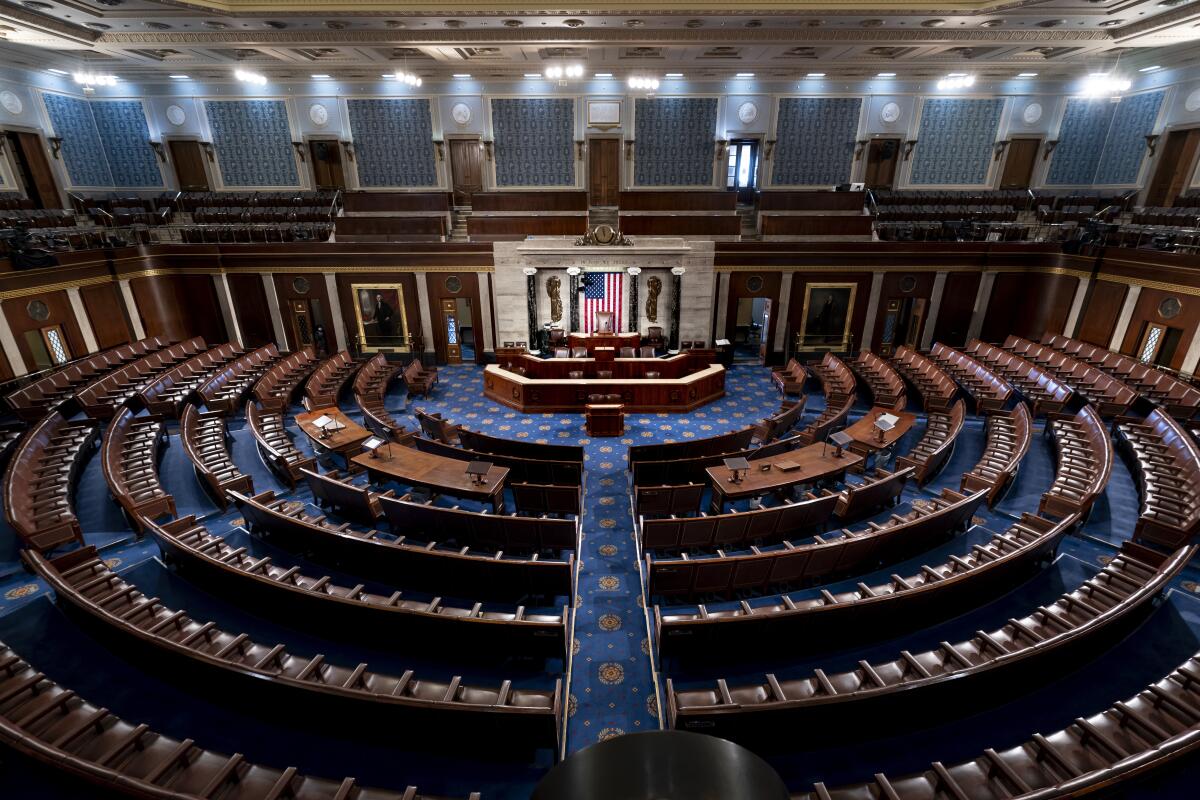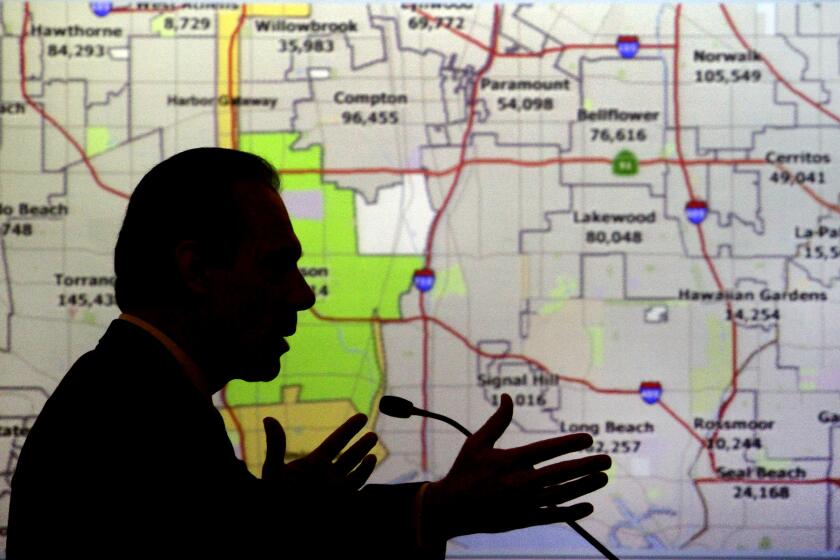Democrats and Republicans fight to a draw in national redistricting battle

- Share via
After nearly a year of partisan battles, number-crunching and lawsuits, the once-a-decade congressional redistricting cycle is ending in a draw.
It leaves Republicans in position to win control of the House of Representatives even if they come up just short of winning a majority of the national vote. That frustrates Democrats, who had hoped to shift the dynamic so that their success with the popular vote would better be reflected by political power in Washington. Some Republicans, meanwhile, had hoped to cement an even larger advantage this time.
But the parties ultimately fought each other to a stalemate. The new congressional maps have 226 House districts won by Biden in the last presidential election and 209 won by Trump — only one more Biden district than in 2020. Likewise, the typical congressional district voted for Biden by about 2 percentage points more, also almost identical to 2020.
“It’s almost perfect stasis,” said Nicholas Stephanopoulos, a professor at Harvard Law who follows congressional redistricting. “If you compare the maps we had in 2020 to the maps we’re going to have in 2022, they’re almost identical” in terms of partisan advantage, he added.
The lines of congressional districts have, of course, changed, as some states added new ones — or lost old ones — to match population shifts recorded by the U.S. Census Bureau in 2020.
Redistricting is the once-a-decade adjustment of legislative lines to match the census findings. It is typically an extraordinarily partisan process, with each major party trying to distribute its voters to guarantee wins in the largest number of districts. This cycle was no different, but the end result is virtually no change to the overall partisan orientation of the congressional map.
Gerrymandering remains a significant problem, but so far, Democrats have held their own more than expected. Courts have played a major role.
That leaves the map tilted slightly to the right of the national electorate, since Biden won the presidency by more than 4 percentage points. In a typical year, Democrats would have to win the national popular vote by about 2 percentage points to win a House majority, while the GOP could capture it, theoretically, with just under 50%.
Republicans pointed to that as a victory.
“If we’re fighting to a draw on a map that everyone agrees is good for Republicans, that’s good for Republicans,” said Adam Kincaid, executive director of the National Republican Redistricting Trust, which coordinates redistricting for the party.
Democrats said they were still in a far better place than after the last redistricting round in 2011, which came after a GOP sweep of statehouses that allowed those states to draw a far more slanted series of congressional maps.
Skelton: Gerrymandering still exists in California. But reforms did away with the old, ugly system
The old gerrymandering had a very bad stench and is still practiced in many states including Texas, columnist George Skelton writes.
“We are in a stronger position than in 2020 and in a way stronger position than in 2012,” said Kelly Ward Burton, executive director of the National Democratic Redistricting Committee.
Assessments of the final outcome became possible after last Tuesday, when New Hampshire became the final state to adopt a new congressional map.
On Thursday, Florida’s Supreme Court ruled that it wouldn’t consider a Democratic challenge to a map pushed by Republican Gov. Ron DeSantis before the November election, ending the last significant legal uncertainty over the maps for now.
The odds are that the national map will improve for the GOP after November, however.
If Republicans do well in the midterm election — as is widely expected — they could capture seats on state supreme courts in North Carolina or Ohio that would allow them to redraw maps rejected by previous courts as too slanted. Similarly, if the GOP seizes power in more state Legislatures or governor’s mansions, the party could redraw maps in those states in 2023 that would be implemented for the coming decade.
Get our L.A. Times Politics newsletter
The latest news, analysis and insights from our politics team.
You may occasionally receive promotional content from the Los Angeles Times.
And the U.S. Supreme Court’s conservative majority has indicated that next year it will reconsider some of the guidelines that govern legislative line-drawing nationally, which could open the door to even further Republican gains.
It’s a reversal from earlier this year, when Democrats were poised to lessen the partisan bias of the congressional map, at least in 2022.
But the centerpiece of that effort — a pro-Democratic map in New York state — was ruled an illegal partisan gerrymander by the state’s Democratic-appointed top court, and the court’s redrawn map favored the party less. A similarly pro-Democratic map in Maryland was replaced by a more equitable map.
But Florida’s strongly pro-GOP map, which DeSantis pushed the Republican-controlled Legislature into adopting, was not overturned by its majority-GOP-appointed high court, bringing the national partisan pendulum back to the center.
New commissions approved by voters to reduce partisan gamesmanship in redistricting are instead splitting along partisan lines in some states.
Democrats were already fighting on an uneven playing field during this round of redistricting. They controlled the drawing of maps in states that represent only 75 House districts, while Republicans held the pen in states that contain a total of 187 districts. That’s partly due to lingering effects of the GOP statehouse gains in 2010 and partly because many Democratic-controlled states, such as California, Colorado and New Jersey, ceded their power to draw lines to independent commissions to take partisan politics out of redistricting.
The Democratic Party has embraced that approach nationally, pushing for it in all 50 states as part of its voting overhaul, which foundered in the Senate earlier this year amid unanimous GOP opposition. But some Democrats have questioned whether the stance amounts to unilateral disarmament in the partisan cage-match of redistricting.
After this cycle, Stephanopoulos said, there will no longer be much debate.
“If all the blue states reform and all the red states run wild, that’s not a good outcome,” he said.
Though the map’s partisan lean didn’t change, the number of competitive House seats diminished. That’s partly because Republicans, who maximized their gains in the post-2010 redistricting cycle, focused on packing as many GOP voters as possible into the districts of some of their incumbents facing tough reelection campaigns.
Justice Samuel Alito’s order to put a hold on a ruling may determine whether David McCormick or Dr. Mehmet Oz wins Pennsylvania’s GOP Senate primary.
The number of House seats decided by a 10-point margin or less dropped from 89 to 76, largely by the GOP changing 14 of its competitive seats into safe ones, Kincaid said.
Advocates of sweeping redistricting changes warn that the loss of competition is dangerous for democracy.
“Partisan balance is one thing, but it’s much more important to think about how gridlock and extremism is driven by the fact that the only competition is in primaries,” said Joshua Graham Lynn, founder of the group RepresentUS, which pushes for changes in redistricting.
Currently, 10 states have independent commissions that draw lines for congressional districts. Some reformers fear there are few places left to push for independent panels, because they may have to be created through ballot measures since legislators are not inclined to write laws to give up their own power. Only Ohio and Florida, two states that already have voter-backed prohibitions against partisan redistricting, remain as promising targets for ballot measures to create new commissions.
More to Read
Get the L.A. Times Politics newsletter
Deeply reported insights into legislation, politics and policy from Sacramento, Washington and beyond. In your inbox twice per week.
You may occasionally receive promotional content from the Los Angeles Times.














